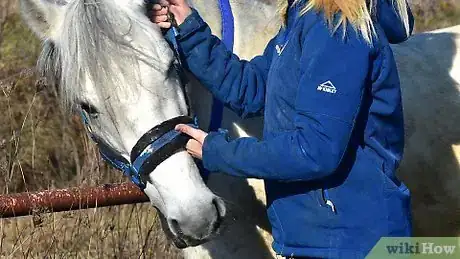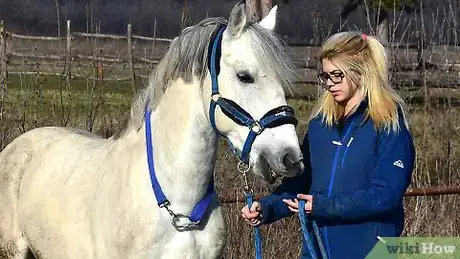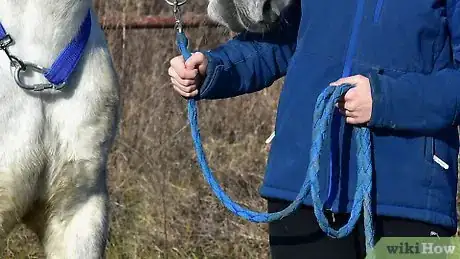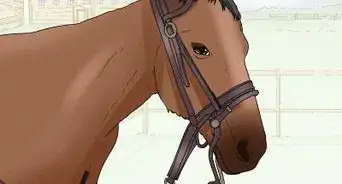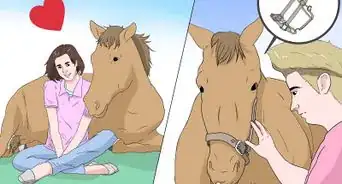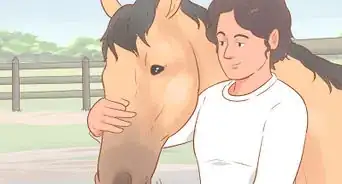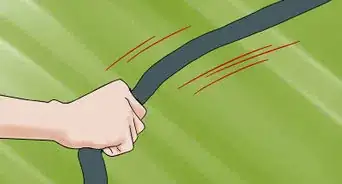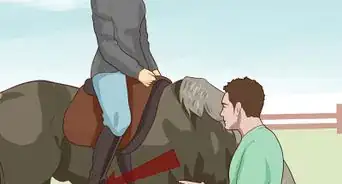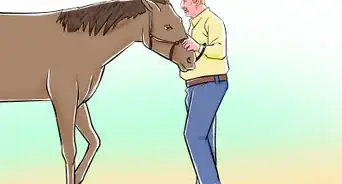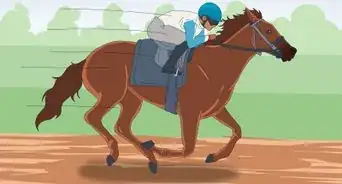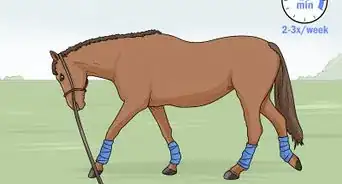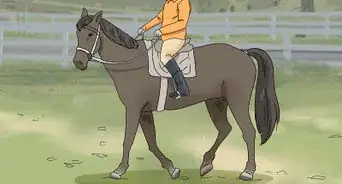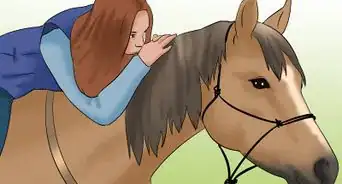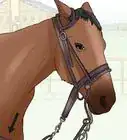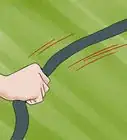This article was co-authored by Kate Jutagir. Kate Jutagir is an Equestrian Specialist, Hunter/Jumper Trainer, and the Owner of Blackhound Equestrian, a premier training barn located on 65 acres in Castro Valley, California. Originally designed to be a riding school used as a springboard for dedicated students into careers in the sport, Blackhound Equestrian has grown into a hunter/jumper training program for all levels focusing on providing a solid foundation needed for personal advancement in the sport. Kate has over 25 years of equestrian instruction and training experience. Her focus on developing horse and rider partnerships provides a complete equestrian education for both beginners and advanced riders alike.
There are 9 references cited in this article, which can be found at the bottom of the page.
This article has been viewed 126,305 times.
Leading a horse is an important component of ground training—training that you do with your horse when you are standing on the ground. When you are able to lead your horse, you will have a much easier time controlling his movements, as well as tying him to a hitching rail and trailering him.[1] Leading your horse will also help you better communicate with him.[2] With time and patience, you will be able to successfully lead your horse and improve your relationship with him.
Steps
Preparing to Lead Your Horse
-
1Obtain the equipment to lead your horse. You will need a few tools to lead your horse: halter, lead rope, gloves, and dressage whip. The halter will fit snugly yet comfortably on your horse’s head, and the lead the rope will attach to the halter. The gloves are useful to protect your hands from rope burns and/or irritation.[3]
- The dressage whip is a semi-rigid rod that is about 36 to 44 inches (91 to 110 cm) in length. The semi-rigidness will prevent the horse from experiencing painful or bothersome pokes from the whip.[4]
- Lead ropes come in different materials. Cotton lead ropes can be more forgiving on your hands (if you are not wearing gloves),[5] but may rot or mildew if stored when wet. Polypropylene lead ropes have several advantages, including being soft and flexible and easy to grip.[6]
- Nylon lead ropes are also available.[7]
- Choose a lead rope that is about 8 to 10 feet (2 to 3 m) long.
- A rope halter with a rope crown snap is useful when teaching a horse to yield to pressure. Pressure is sometimes needed when leading a horse.[8]
- Treats will also be helpful to have on hand. Examples of tasty treats include cut-up apples or carrots and horse cookies.[9]
-
2Place the halter on your horse. Attach your lead rope to the halter before placing it on your horse. Holding the unbuckled halter in your left hand, stand on your horse’s left side and slowly guide your right hand over his neck to guide his head toward you. With your right hand, slowly guide the halter’s nosepiece over your horse’s muzzle and the headstall over and behind his ears.[10]
- Do not poke your horse’s eyes as you are positioning the halter.[11]
- Secure the halter. Keep in mind that halters have different ways of being secured (e.g., buckles, snaps, clips).[12]
- Talk to your horse in a reassuring voice as you are placing the halter on him.
- Having the lead rope already attached will give you some control if your horse tries to pull away as you put the halter on.[13]
Advertisement -
3Check the fit of the halter. A halter that does not fit properly will create challenges when leading a horse. You should be to fit two fingers easily and snugly between your horse and the noseband.[14] Adjust the halter accordingly if it fits too tightly or too loosely.
- Your horse may signal his discomfort if the halter is too tight on his head or behind his ears.
-
4Stand on your horse’s left side. A horse’s left side is the customary position to lead a horse.[15] You can stand so that you are either even with your horse’s head or about halfway between his head and shoulder.[16]
- Stand about 12 inches (30 cm) away from your horse.[17]
- Leading a horse is possible from the lead (in front of your horse) or drive positions (behind your horse’s withers), but is not as safe as standing by your horse’s side.
-
5
Teaching Your Horse to Yield His Hindquarters
-
1Apply pressure with your lead rope. An important aspect of leading your horse is teaching him how to yield his hindquarters from a standstill. To begin, face your horse’s left side. With the lead rope in your left hand, apply even pressure with the lead rope to get your horse to turn his head turns towards you.
- Teaching your horse to yield his hindquarters is important because he may have the tendency to do a partial halt when being led: stopping his front legs while moving his hindquarters in a quarter circle.[22]
- A full halt is when your horse can yield both his front and hindquarters.
-
2Tap your horse’s left ankle with the dressage whip. Hold the dressage whip in your right hand. Use gentle taps on your horse’s left ankle (inside hind leg) to coax your horse to move that leg in, forward and in front the outside hind leg.[23]
-
3Practice consistently.[27] Initially, your horse may kick the leg you are tapping. In addition, he may move his outside hind leg.[28] If he moves his outside hind leg, follow his movements, but continue to tap on his inside leg. Eventually, he will stop moving the outside hind leg and move only the inside hind leg.
- Keep your practice sessions relatively short—about 10 to 15 minutes.[29]
Training Your Horse to Move Forward and Halt
-
1Give your horse a verbal cue to move forward. Position yourself as when you taught him to yield his hindquarters: facing his left side with the lead rope in your left hand and the dressage whip in your right hand. As you take your first step forward, give your horse a verbal cue (e.g., a soft clucking or kissing noise).[30]
-
2Tap your horse’s hips. Start tapping your horse’s hip with the whip after you give the verbal cue, but before your foot hits the ground. The timing of when you start tapping is important so that your horse learns to associate the verbal cue with forward movement.[33]
- Space the taps about one second apart.[34]
- Continue tapping until your horse moves forward. If he moves in any direction other than forward, follow his movements and continue tapping. Make sure not to apply any additional pressure to his halter or lead rope if he moves in the wrong direction.[35]
- Stop the tapping immediately when he begins to step forward.[36]
-
3Say ‘whoa.’ This verbal cue indicates to your horse that he has walked forward to the correct location. He may not understand this cue initially, and may even continue walking past the desired location. If he does this, say ‘whoa’ again and apply backward pressure to his lead rope to encourage him to walk backward to the right spot.[37]
- It is important for you to stop tapping when he reaches the correct spot.[38] In time, he should be able to stop according to your verbal ‘whoa,’ rather than when you stop tapping.
Leading Your Horse Through Various Openings
-
1Lead your horse through a narrow opening. Narrow openings, such as a stall door, can be dangerous to move through with your horse. He may be reluctant to move forward because the inside of the area looks different from the outside. This reluctance may lead to bolting or extreme resistance, both of which could injure you.
- To safely lead your horse through a narrow opening, it is advisable for you to walk through the opening first, then let your horse walk through when he is calm.[39]
- Make sure to quickly move to the side of the opening after you move through and before you cue your horse to move forward. This will prevent your horse from crowding you as he walks through the opening.[40]
-
2Lead your horse through a swing gate. A swing gate is wider than a stall door. However, you will still need to control your horse as he moves through it. While leading your horse from his left side, approach the gate with as much room as possible to open the gate. Unlatch the gate with one hand while keeping a firm hold on your horse’s lead rope with your other hand.
- Open the gate widely enough for you and your horse to walk through easily. Your horse should not have to back up and reposition to get through the gate.
- Make sure to swing the gate closed when you and your horse have gone through it to prevent other animals from entering through the gate.
- Do not walk in front of the horse when walking through the gate. Horses tend to move quickly through openings, and he may injure you if he moves quickly when you are in front of him.
-
3Remove the halter and lead rope. Once you and your horse have safely moved through the opening, you can release him by removing his halter and lead rope. You should remove his lead rope before removing his halter. This will prevent your horse from rearing back and developing a bad habit of pulling on his halter.[41]
- Before removing the halter and lead rope, turn your horse so that he is facing you and the opening.[42]
- Although this may be easier said than done, do not let your horse bolt after being released.[43] You may want to consult with your veterinarian or equine behaviorist for tips on how to keep your horse from bolting.
Expert Q&A
Did you know you can get expert answers for this article?
Unlock expert answers by supporting wikiHow
-
QuestionWhy do you need to know how to lead a horse?
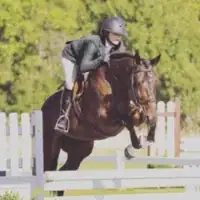 Kate JutagirKate Jutagir is an Equestrian Specialist, Hunter/Jumper Trainer, and the Owner of Blackhound Equestrian, a premier training barn located on 65 acres in Castro Valley, California. Originally designed to be a riding school used as a springboard for dedicated students into careers in the sport, Blackhound Equestrian has grown into a hunter/jumper training program for all levels focusing on providing a solid foundation needed for personal advancement in the sport. Kate has over 25 years of equestrian instruction and training experience. Her focus on developing horse and rider partnerships provides a complete equestrian education for both beginners and advanced riders alike.
Kate JutagirKate Jutagir is an Equestrian Specialist, Hunter/Jumper Trainer, and the Owner of Blackhound Equestrian, a premier training barn located on 65 acres in Castro Valley, California. Originally designed to be a riding school used as a springboard for dedicated students into careers in the sport, Blackhound Equestrian has grown into a hunter/jumper training program for all levels focusing on providing a solid foundation needed for personal advancement in the sport. Kate has over 25 years of equestrian instruction and training experience. Her focus on developing horse and rider partnerships provides a complete equestrian education for both beginners and advanced riders alike.
Equestrian Specialist & Trainer
-
QuestionWhen can I start leading a horse?
 Kate JutagirKate Jutagir is an Equestrian Specialist, Hunter/Jumper Trainer, and the Owner of Blackhound Equestrian, a premier training barn located on 65 acres in Castro Valley, California. Originally designed to be a riding school used as a springboard for dedicated students into careers in the sport, Blackhound Equestrian has grown into a hunter/jumper training program for all levels focusing on providing a solid foundation needed for personal advancement in the sport. Kate has over 25 years of equestrian instruction and training experience. Her focus on developing horse and rider partnerships provides a complete equestrian education for both beginners and advanced riders alike.
Kate JutagirKate Jutagir is an Equestrian Specialist, Hunter/Jumper Trainer, and the Owner of Blackhound Equestrian, a premier training barn located on 65 acres in Castro Valley, California. Originally designed to be a riding school used as a springboard for dedicated students into careers in the sport, Blackhound Equestrian has grown into a hunter/jumper training program for all levels focusing on providing a solid foundation needed for personal advancement in the sport. Kate has over 25 years of equestrian instruction and training experience. Her focus on developing horse and rider partnerships provides a complete equestrian education for both beginners and advanced riders alike.
Equestrian Specialist & Trainer
-
QuestionHow quickly can a horse learn how to be led?
 Kate JutagirKate Jutagir is an Equestrian Specialist, Hunter/Jumper Trainer, and the Owner of Blackhound Equestrian, a premier training barn located on 65 acres in Castro Valley, California. Originally designed to be a riding school used as a springboard for dedicated students into careers in the sport, Blackhound Equestrian has grown into a hunter/jumper training program for all levels focusing on providing a solid foundation needed for personal advancement in the sport. Kate has over 25 years of equestrian instruction and training experience. Her focus on developing horse and rider partnerships provides a complete equestrian education for both beginners and advanced riders alike.
Kate JutagirKate Jutagir is an Equestrian Specialist, Hunter/Jumper Trainer, and the Owner of Blackhound Equestrian, a premier training barn located on 65 acres in Castro Valley, California. Originally designed to be a riding school used as a springboard for dedicated students into careers in the sport, Blackhound Equestrian has grown into a hunter/jumper training program for all levels focusing on providing a solid foundation needed for personal advancement in the sport. Kate has over 25 years of equestrian instruction and training experience. Her focus on developing horse and rider partnerships provides a complete equestrian education for both beginners and advanced riders alike.
Equestrian Specialist & Trainer
Warnings
- If the horse is not yours, and it is your first time leading, have the owner or someone familiar with the horse come with you. (You don't want to spook the horse.)⧼thumbs_response⧽
- Wearing jewelry while leading your horse poses a danger.[49] It can easily get tangled in the lead rope, which could prevent you from releasing the lead rope if your horse decides to bolt.⧼thumbs_response⧽
- Never wrap the excess lead rope around your hand.[50]⧼thumbs_response⧽
- Your horse is much stronger than you, so you should not try to out-pull him.[51]⧼thumbs_response⧽
References
- ↑ https://www.aspca.org/pet-care/virtual-pet-behaviorist/horse-behavior/teaching-your-horse-lead
- ↑ https://www.aspca.org/pet-care/virtual-pet-behaviorist/horse-behavior/teaching-your-horse-lead
- ↑ https://www.aspca.org/pet-care/virtual-pet-behaviorist/horse-behavior/teaching-your-horse-lead
- ↑ https://www.aspca.org/pet-care/virtual-pet-behaviorist/horse-behavior/teaching-your-horse-lead
- ↑ https://www.aspca.org/pet-care/virtual-pet-behaviorist/horse-behavior/teaching-your-horse-lead
- ↑ http://www.horses-and-horse-information.com/articles/horse-lead-training.shtml
- ↑ https://www.aspca.org/pet-care/virtual-pet-behaviorist/horse-behavior/teaching-your-horse-lead
- ↑ http://www.horses-and-ponies.com/horse-care/basic/how-to-halter-a-horse-or-pony/
- ↑ https://www.aspca.org/pet-care/virtual-pet-behaviorist/horse-behavior/teaching-your-horse-lead
- ↑ Kate Jutagir. Equestrian Specialist & Trainer. Expert Interview. 31 March 2020.
- ↑ http://www.horses-and-ponies.com/horse-care/basic/how-to-halter-a-horse-or-pony/
- ↑ http://www.horses-and-ponies.com/horse-care/basic/how-to-halter-a-horse-or-pony/
- ↑ http://www.horses-and-ponies.com/horse-care/basic/how-to-halter-a-horse-or-pony/
- ↑ http://www.equisearch.com/discoverhorses/article/how-to-halter-a-horse
- ↑ http://www2.ca.uky.edu/agc/pubs/4af/4af05ma/4af05ma.htm
- ↑ http://www2.ca.uky.edu/agc/pubs/4af/4af05ma/4af05ma.htm
- ↑ https://www.aspca.org/pet-care/virtual-pet-behaviorist/horse-behavior/teaching-your-horse-lead
- ↑ http://nasdonline.org/1040/d000838/leading-horses-safely.html
- ↑ http://nasdonline.org/1040/d000838/leading-horses-safely.html
- ↑ http://www.equusite.com/articles/safety/safetyLeading.shtml
- ↑ http://nasdonline.org/1040/d000838/leading-horses-safely.html
- ↑ http://www.horses-and-horse-information.com/articles/horse-lead-training.shtml
- ↑ https://www.aspca.org/pet-care/virtual-pet-behaviorist/horse-behavior/teaching-your-horse-lead
- ↑ https://www.aspca.org/pet-care/virtual-pet-behaviorist/horse-behavior/teaching-your-horse-lead
- ↑ https://www.aspca.org/pet-care/virtual-pet-behaviorist/horse-behavior/teaching-your-horse-lead
- ↑ https://www.aspca.org/pet-care/virtual-pet-behaviorist/horse-behavior/teaching-your-horse-lead
- ↑ Kate Jutagir. Equestrian Specialist & Trainer. Expert Interview. 31 March 2020.
- ↑ https://www.aspca.org/pet-care/virtual-pet-behaviorist/horse-behavior/teaching-your-horse-lead
- ↑ http://www.horses-and-horse-information.com/articles/horse-lead-training.shtml
- ↑ https://www.aspca.org/pet-care/virtual-pet-behaviorist/horse-behavior/teaching-your-horse-lead
- ↑ https://www.aspca.org/pet-care/virtual-pet-behaviorist/horse-behavior/teaching-your-horse-lead
- ↑ https://www.aspca.org/pet-care/virtual-pet-behaviorist/horse-behavior/teaching-your-horse-lead
- ↑ https://www.aspca.org/pet-care/virtual-pet-behaviorist/horse-behavior/teaching-your-horse-lead
- ↑ https://www.aspca.org/pet-care/virtual-pet-behaviorist/horse-behavior/teaching-your-horse-lead
- ↑ https://www.aspca.org/pet-care/virtual-pet-behaviorist/horse-behavior/teaching-your-horse-lead
- ↑ https://www.aspca.org/pet-care/virtual-pet-behaviorist/horse-behavior/teaching-your-horse-lead
- ↑ https://www.aspca.org/pet-care/virtual-pet-behaviorist/horse-behavior/teaching-your-horse-lead
- ↑ https://www.aspca.org/pet-care/virtual-pet-behaviorist/horse-behavior/teaching-your-horse-lead
- ↑ http://nasdonline.org/1040/d000838/leading-horses-safely.html
- ↑ http://www2.ca.uky.edu/agc/pubs/4af/4af05ma/4af05ma.htm
- ↑ Kate Jutagir. Equestrian Specialist & Trainer. Expert Interview. 31 March 2020.
- ↑ http://nasdonline.org/1040/d000838/leading-horses-safely.html
- ↑ http://www2.ca.uky.edu/agc/pubs/4af/4af05ma/4af05ma.htm
- ↑ http://www.horses-and-horse-information.com/articles/horse-lead-training.shtml
- ↑ https://www.aspca.org/pet-care/virtual-pet-behaviorist/horse-behavior/teaching-your-horse-lead
- ↑ https://www.aspca.org/pet-care/virtual-pet-behaviorist/horse-behavior/teaching-your-horse-lead
- ↑ http://www.horses-and-horse-information.com/rearing.html
- ↑ http://nasdonline.org/1040/d000838/leading-horses-safely.html
- ↑ http://www2.ca.uky.edu/agc/pubs/4af/4af05ma/4af05ma.htm
- ↑ http://www.horses-and-horse-information.com/articles/horse-lead-training.shtml
- ↑ http://www2.ca.uky.edu/agc/pubs/4af/4af05ma/4af05ma.htm
About This Article
Before you lead a horse, attach a lead rope to a halter and fit the halter over the horse’s head. Then, adjust the halter so that you can easily fit 2 fingers between the horse and the noseband. Once the halter is on snugly, stand about 12 inches from the horse’s left side so that you’re even with its head. Next, hold the lead rope with your right hand and fold up any excess rope in your left hand. When you want to move, face the horse’s left side and give it a verbal cue, like a clucking or kissing noise, as you move forward. For advice from our Veterinary reviewer on how to lead your horse through narrow openings, read on!


